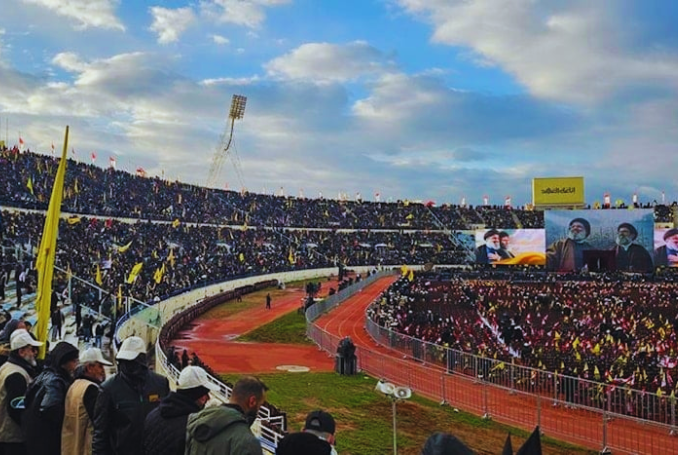
By sta
A monumental funeral procession in Beirut commemorates Hezbollah leaders Sayyed Hassan Nasrallah and Sayyed Hashem Safieddine, drawing thousands and international delegations.
The Lebanese movement Hezbollah prepared for a monumental funeral procession on Sunday for two of its most revered figures: Sayyed Hassan Nasrallah, the historic leader of the movement, and Sayyed Hashem Safieddine, the former Secretary General, both assassinated by Israel.
The funeral ceremony drew thousands from both Lebanon and abroad, and attracted high-ranking political and religious figures from across the globe.
The streets of Beirut have been flooded with mourners since the early hours of the morning, with many arriving long before dawn to secure a place at the event, the Lebanese news network Al Mayadeen reported.
By 6 AM local time, the city’s Camille Chamoun Sports City Stadium had already filled to capacity, with some attendees even spending the night outdoors to guarantee their spot.
The ceremony began at 1 PM local time. The coffins of the two leaders arrive in a specially designed vehicle at the stadium, where Hezbollah’s Secretary General, Sheikh Naim Qassem, is expected to deliver a speech.
Following the speeches, the procession will move toward Sayyed Nasrallah’s final resting place on the outskirts of Beirut’s Southern Suburb.
Large portraits of Sayyed Nasrallah and Sayyed Safieddine have been displayed at the stadium and along the route leading to the burial site, paying tribute to their enduring legacy.
Massive Preparations
The scale of the funeral is expected to be unprecedented, with official organizers confirming that representatives from 79 countries, including high-ranking officials from Iran, Iraq, and other nations, will attend in both official and popular capacities.
Iranian Parliament Speaker Mohammad Baqer Qalibaf and Foreign Minister Abbas Araqchi have arrived to the funeral in Beirut. pic.twitter.com/pwV1l33FzE
— The Palestine Chronicle (@PalestineChron) February 23, 2025
By 7 AM, just an hour after the stadium gates were opened, all 23,000 designated seats on the field were occupied, while an additional 55,000 seats were arranged in the stands. Tens of thousands more are anticipated to join the procession from the surrounding streets, according to Al Mayadeen..
Large screens have reportedly been erected along the procession route to ensure that all attendees can follow the proceedings, and dozens of tents have been set up to accommodate the large crowds.
To ensure the safety and health of all those in attendance, the Islamic Health Society has deployed 1,500 medical volunteers, including paramedics, doctors, and nurses, across 60 medical tents along the route.
Furthermore, 100 ambulances have been stationed to provide immediate medical assistance if needed. These extensive preparations reflect the enormous scale of the funeral and the level of coordination required to manage the anticipated turnout.
International Delegations Arrive in Beirut
In addition to the massive crowd, the funeral has attracted a host of high-level international delegates.
Iranian Foreign Minister Abbas Araghchi, accompanied by Speaker of the Iranian Parliament Mohammad Bagher Ghalibaf, arrived in Beirut on Sunday to attend the funeral. Araghchi emphasized the symbolic significance of the event, stating that it was proof that “the Resistance is alive and will achieve divine victory.” Ghalibaf also underscored the strong ties between Lebanon and Iran, expressing hopes for continued cooperation and support.
Also attending the ceremony are the families of martyrs, including former Iranian President Raisi, former Iranian Foreign Ministry Hossein Amir-Abdollahian, and General Qassem Soleimani, along with senior Iranian officials such as Mohsen Rezaee, an advisor to the Iranian president, and a delegation of 40 Iranian parliamentarians.
View of the large gathering of crowds at Beirut’s Sports City Stadium attending the funeral of late Hezbollah leaders Hassan Nasrallah and Hashem Safieddine. pic.twitter.com/swZos1Hija
— The Palestine Chronicle (@PalestineChron) February 23, 2025
Additionally, a Yemeni delegation has arrived in Beirut to participate in the funeral, marking another significant sign of solidarity in the region. The Yemeni delegation’s participation reflects the broader scope of Hezbollah’s influence and its vital role in the broader Resistance Axis.
The Significance of the Leaders’ Legacy
Sayyed Hassan Nasrallah and Sayyed Hashem Safieddine were not only central figures in the Hezbollah movement but also key leaders in the region.
Their leadership and strategic guidance played a critical role in shaping the course of regional geopolitics and in galvanizing support for Palestinian resistance.
Nasrallah’s leadership transformed Hezbollah into a formidable force in the region, while Safieddine’s legacy was defined by his unwavering commitment to Hezbollah’s cause.
Both leaders are revered by their followers for their role in empowering the resistance, particularly in relation to the Palestinian cause. Their influence extended well beyond Lebanon’s borders, contributing to the formation of a broader Resistance Axis that has reshaped the Middle East.
(PC, Al Mayadeen)